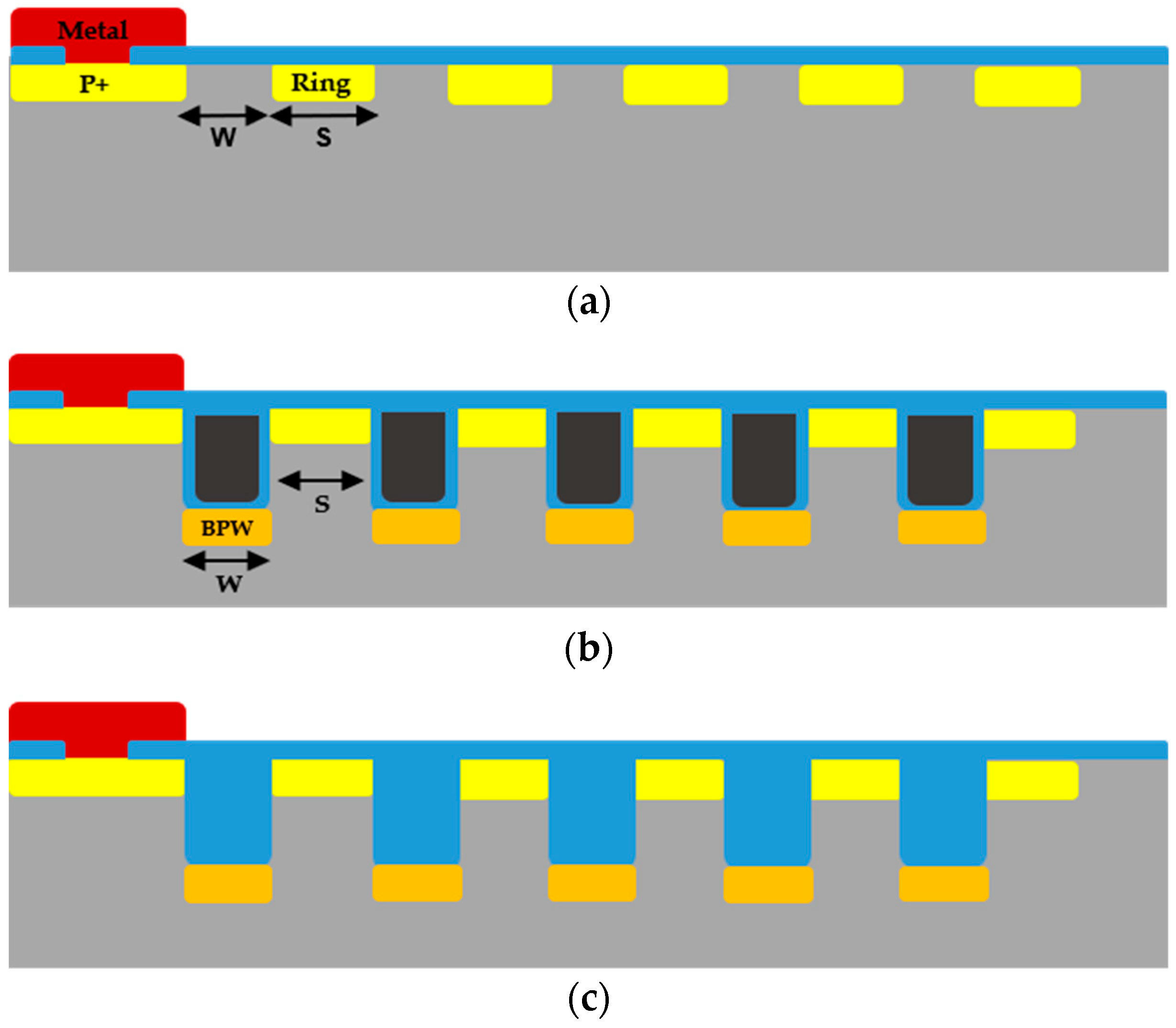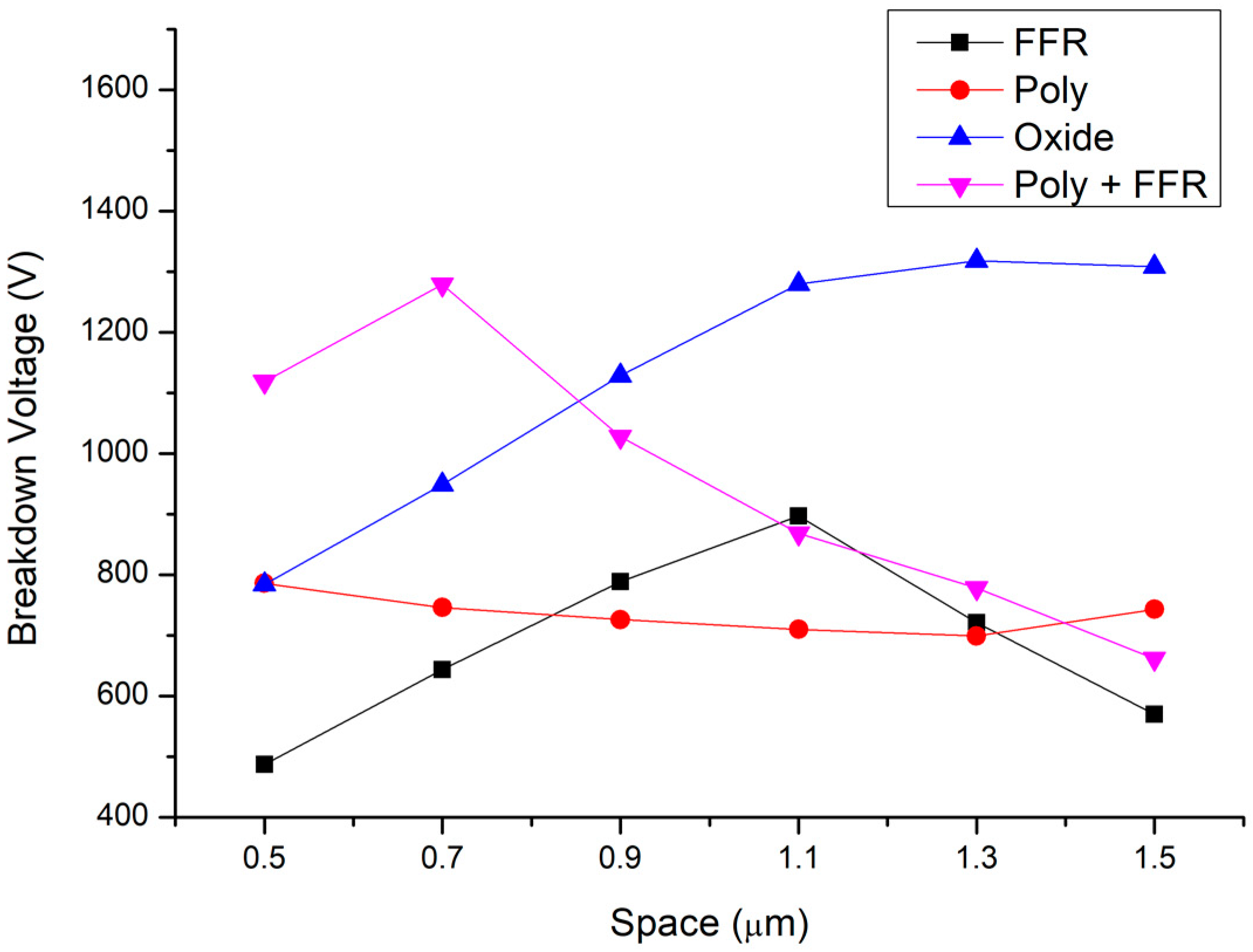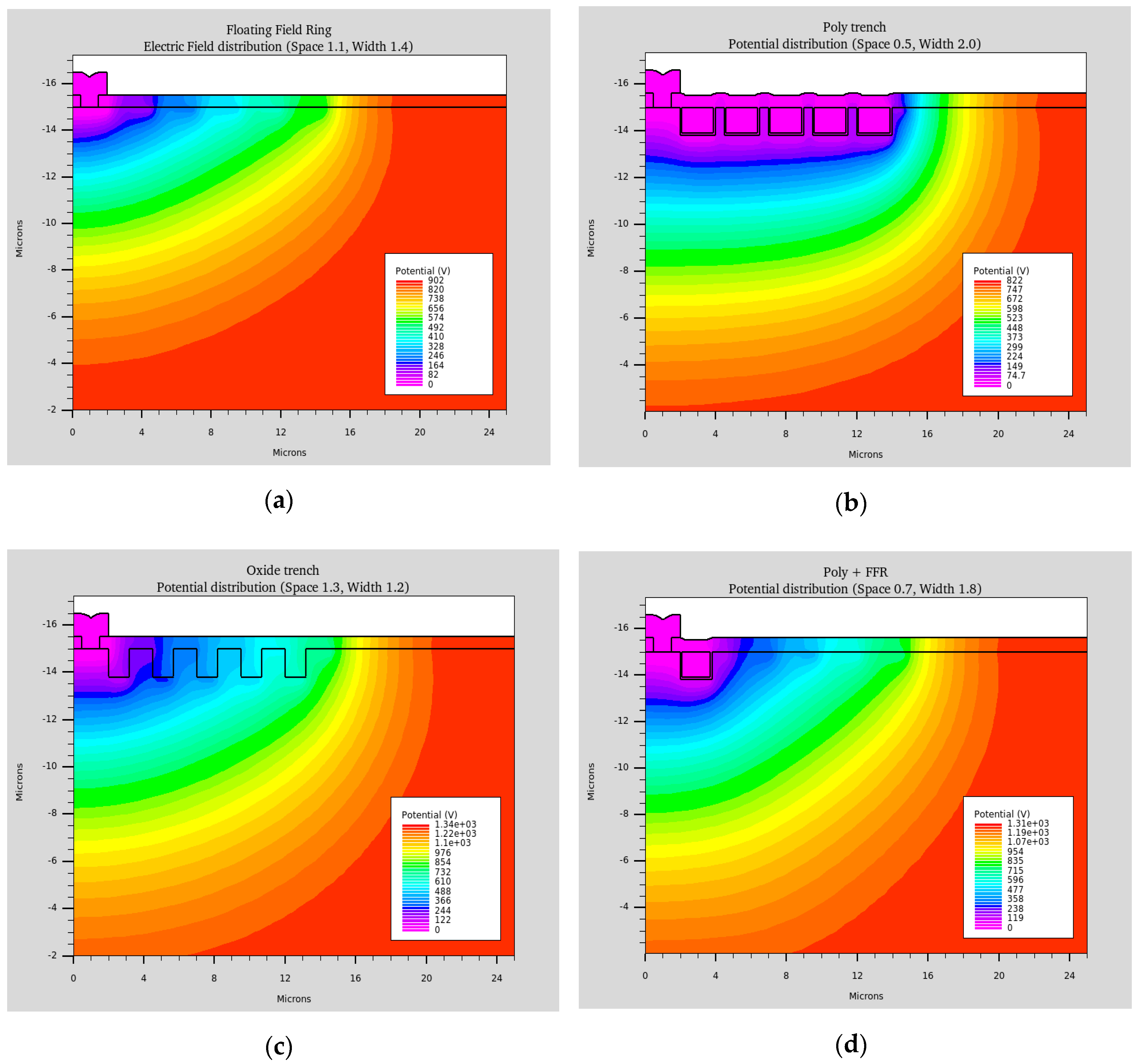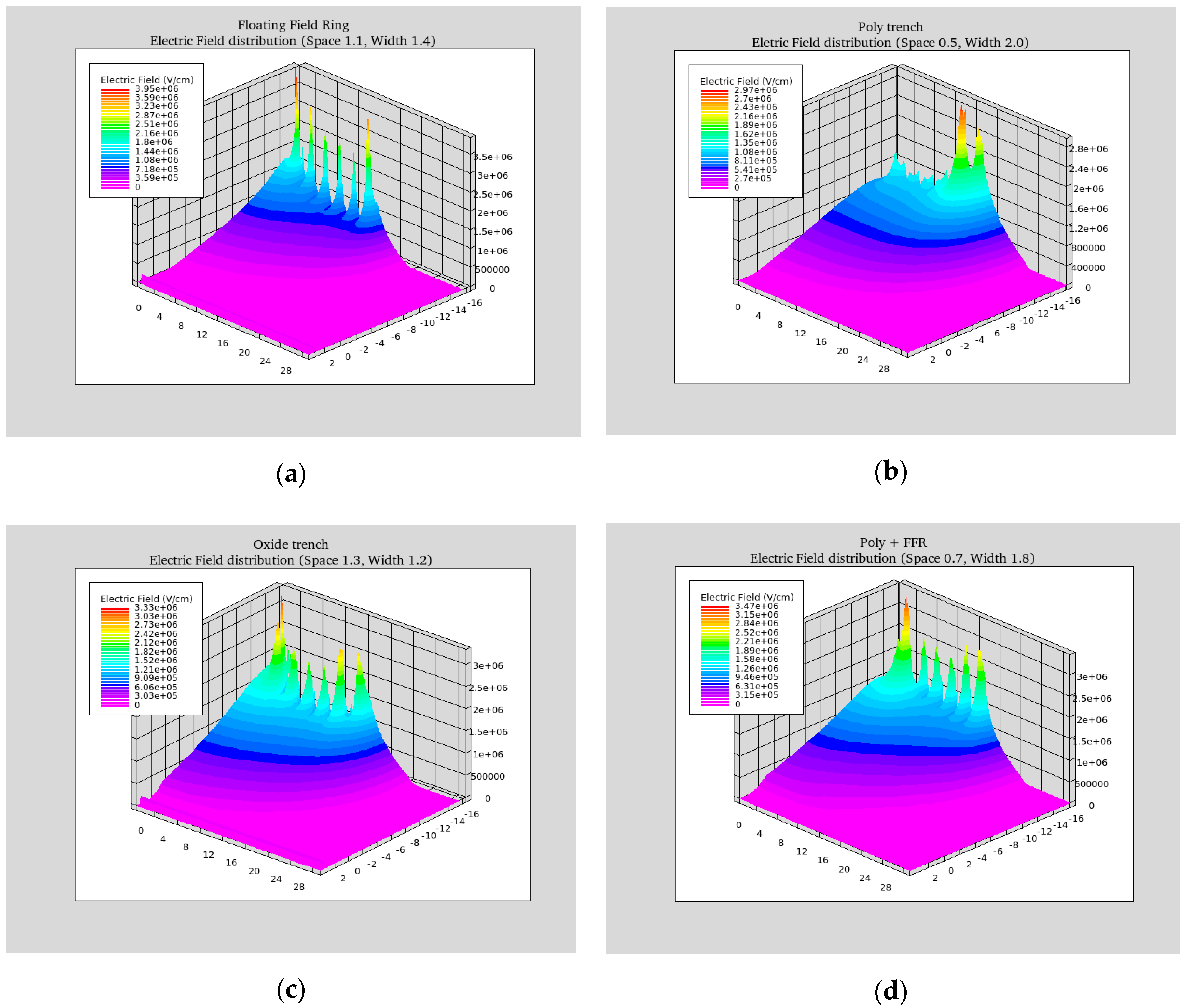Study of a SiC Trench MOSFET Edge-Termination Structure with a Bottom Protection Well for a High Breakdown Voltage
Abstract
:1. Introduction
2. Device Structure and Models
3. Simulation Results and Discussion
3.1. Breakdown Voltage Characteristics and Potential Distributions
3.2. Electric Field Distribution of Edge-Termination Structures
4. Conclusions
Author Contributions
Funding
Acknowledgments
Conflicts of Interest
References
- Jayant Baliga, B. Fundamentals of Power Semiconductor Devices; Springer: New York, NY, USA, 2009; pp. 107–162, 296–298. [Google Scholar]
- Sheridan, D.C.; Niu, G.; Merret, J.N.; Cressler, J.D.; Ellis, C.; Tin, C.C. Design and fabrication of planar guard ring termination for high-voltage SiC diodes. Solid State Electron. 2000, 44, 1367–1372. [Google Scholar] [CrossRef]
- Kimoto, T.; Cooper, J.A. Fundamentals of Silicon Carbide Technology: Growth, Characterization, Devices and Applications; John Wiley/Sons: Singapore, 2014; pp. 321–326, 423–432. [Google Scholar]
- Takaya, H.; Miyagi, K.; Hamada, K.; Okura, Y.; Tokura, N.; Kuroyanagi, A. Floating island and thick bottom oxide trench gate MOSFT (FITMOS)-a 60V ultra low on-resistance novel MOSFET with superior internal body diode. In Proceedings of the 17th International Symposium on Power Semiconductor Devices and ICs, Santa Barbara, CA, USA, 23–26 May 2005; pp. 43–46. [Google Scholar]
- Tam, J.; Cooper, J.A.; Melloch, M.R. High-voltage accumulation-layer UMOSFET’s in 4H-SiC. IEEE Electron. Device Lett. 2016, 37, 487–488. [Google Scholar]
- Kagawa, Y.; Fujiwara, N.; Sugawara, K.; Tanaka, R.; Fukui, Y.; Yamamoto, Y.; Miura, N.; Imaizumi, M.; Nakata, S.; Yamakawa, S. 4H-SiC trench MOSFET with bottom oxide protection. Mater. Sci. Forum 2014, 778, 919–922. [Google Scholar] [CrossRef]
- Takaya, H.; Morimoto, J.; Yamamoto, T.; Sakakibara, J.; Watanabe, Y.; Soejima, N.; Hamada, K. 4H-SiC Trench MOSFET with Thick Bottom Oxide. Mater. Sci. Forum 2013, 740, 683–686. [Google Scholar] [CrossRef]
- Li, Y.; Cooper, J.A.; Capano, M.A. High-voltage (3kV) UMOSFETs in 4H-SiC. IEEE Trans. Electron. Devices 2002, 49, 972–975. [Google Scholar] [CrossRef]
- Sui, Y.; Tsuji, T.; Cooper, J.A. On-state Characteristics of SiC power UMOSFETs on 115-um drift Layers. IEEE Trans. Electron. Devices 2005, 26, 255–257. [Google Scholar] [CrossRef]
- Kojima, T.; Harada, S.; Kobayashi, Y.; Sometani, M.; Ariyoshi, K.; Senzaki, J.; Takei, M.; Tanaka, Y.; Okumura, H. Self-aligned formation of the trench bottom shielding region in 4H-SiC trench gate MOSFET. Jpn. J. Appl. Phys. 2016, 55, 04ER02. [Google Scholar] [CrossRef]
- Kim, Y.H.; Lee, H.S.; Kyung, S.S.; Kang, E.G.; Sung, M.Y. A New Edge Termination Technique to Improve Voltage Blocking Capability and Reliability of Field Limiting Ring for Power Devices. In Proceedings of the 2008 IEEE International Conference on Integrated Circuit Design and Technology and Tutorial, Austin, TX, USA, 2–4 June 2008; pp. 71–74. [Google Scholar]
- Konstantinov, A.O.; Wahab, Q.; Nordell, N.; Lindefelt, U. Ionization rates and critical fields in 4H silicon carbide. Appl. Phys. Lett. 1997, 71, 90–92. [Google Scholar] [CrossRef]





| Geometry Parameter | Value |
|---|---|
| Thickness and doping concentration of drift region, / | 15 μm/4 × |
| Doping concentration of p+ ring, | |
| Doping concentration of bottom protection well, | |
| Ring length, S | 0.5~1.5 μm ( |
| A distance between rings, W | 0.5~1.5 μm ( |
| Total S + W length | 2.5 μm |
© 2020 by the authors. Licensee MDPI, Basel, Switzerland. This article is an open access article distributed under the terms and conditions of the Creative Commons Attribution (CC BY) license (http://creativecommons.org/licenses/by/4.0/).
Share and Cite
Jeong, J.-H.; Cha, J.-H.; Kim, G.-H.; Cho, S.-H.; Lee, H.-J. Study of a SiC Trench MOSFET Edge-Termination Structure with a Bottom Protection Well for a High Breakdown Voltage. Appl. Sci. 2020, 10, 753. https://doi.org/10.3390/app10030753
Jeong J-H, Cha J-H, Kim G-H, Cho S-H, Lee H-J. Study of a SiC Trench MOSFET Edge-Termination Structure with a Bottom Protection Well for a High Breakdown Voltage. Applied Sciences. 2020; 10(3):753. https://doi.org/10.3390/app10030753
Chicago/Turabian StyleJeong, Jee-Hun, Ju-Hong Cha, Goon-Ho Kim, Sung-Hwan Cho, and Ho-Jun Lee. 2020. "Study of a SiC Trench MOSFET Edge-Termination Structure with a Bottom Protection Well for a High Breakdown Voltage" Applied Sciences 10, no. 3: 753. https://doi.org/10.3390/app10030753
APA StyleJeong, J.-H., Cha, J.-H., Kim, G.-H., Cho, S.-H., & Lee, H.-J. (2020). Study of a SiC Trench MOSFET Edge-Termination Structure with a Bottom Protection Well for a High Breakdown Voltage. Applied Sciences, 10(3), 753. https://doi.org/10.3390/app10030753




